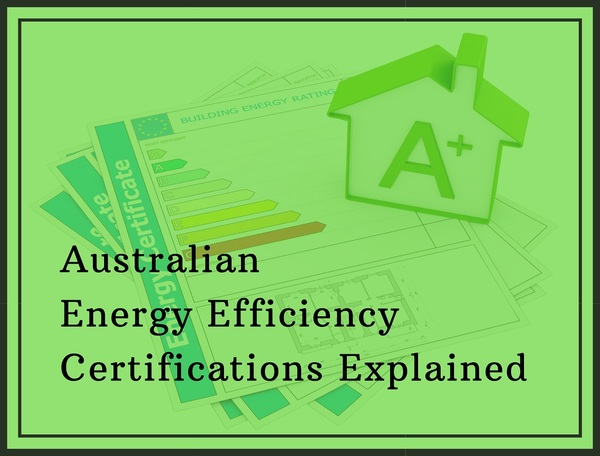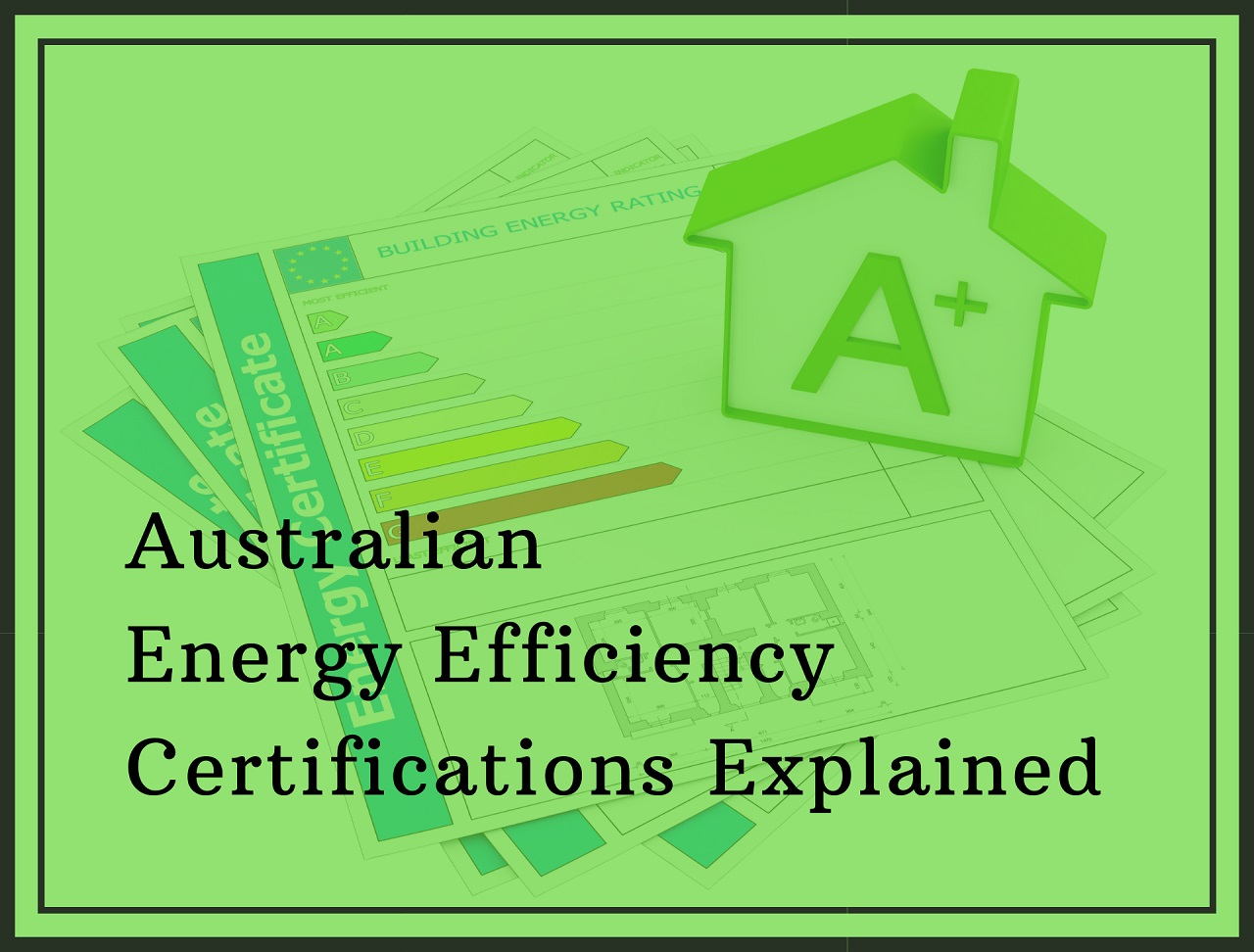Australia’s Home Energy Efficiency Certifications Explained

Our environment is significantly affected by every new building we construct be they commercial or residential devolvement’s. All our buildings and the energy they consume is either directly or indirectly responsible for our high percentage of carbon emissions. The solution lies in understanding just how much energy our buildings are using and knowing how we can make them more efficient moving forward.
In recent times we have seen a rise in awareness around living in a more energy-efficient future. We started in our homes and have since pushed for more environmentally friendly companies. Because of this, a variety of different rating and assessment systems have been implemented to ensure energy efficiency. It’s a simple rule to follow; achieve maximum productivity within our homes with minimal to no wasted energy.
Though the National House Energy Rating Scheme, or NatHERS, as it’s more commonly know, there are several ranking and assessment systems we follow in Australia. Below we’ll introduce a few key house energy rating systems as a resource to ensure your home is comfortable while still using minimal energy.
List of major house energy rating systems to minimise home energy.
- Nationwide House Energy Rating Scheme - NatHERS
- National Australian Built Environment Rating System - NABERS
- Green Star Rating System
- Building Sustainability Index - BASIX
- Window Energy Rating Scheme - WERS
- Energy Efficiency Certification Scheme - EECS

NatHERS (Nationwide House Energy Rating Scheme)
Using a star rating system out of ten, the Nationwide House Energy Rating Scheme or NatHERS measures a home’s energy efficiency based on its design. The rating system is run by the Department of the Environment and Energy and considers the thermal (heating and cooling) performance of a homes design on behalf of the Australia states and territories.
NatHers ratings are based on the following factors :
- The overall design of the home
- Construction materials used
- The climate of the surrounding are
NatHERS is used as a preventative tool, ensuring that buildings are constructed in a way that reduces an occupants reliance on artificial heating and cooling. The rating system can also be used to predict the thermal performance of an existing building, providing energy-efficient solutions with little to no additional construction costs.
Only professionals can conduct NatHERS ratings as all measuring software is custom-built. The rating can go on to be used by homeowners, builders, certifiers and in some cases local, state or national governments to advise and meet the mandatory requirements of the area.

NABERS (National Australian Built Environment Rating System)
The National Australian Built Environment Rating System(NABERS) was built to measure the environmental impact of both commercial and residential buildings with Australia. Their star rating system uses waste and other environmental factors to produce a rating out of 6. On behalf of Commonwealth, state and territory governments, the NSW Office of Environment and Heritage manages NABERS nationally. Unliked NatHERS the tool is widely available for use and operates through comparing utility bills and waste consumption data to existing benchmarks. NABERS uses a range of rating tools to evaluate how your building is performing in the following areas:
- Energy efficiency with and without Greenpower
- Carbon
- Water usage
- Waste management
- Indoor environment quality
Here is a video on how to obtain a NABERS rating-
NABERS also takes into consideration the size, climate, and services provided by the building, but is not used as a predictive tool as the system needs a minimum timeline of 12 months. Over this period, the energy and water bills accumulated calculate the building's energy rating. A NABERS rating can give a clear indication of how other companies or residencies compare to similarly built structures.

Green Star Rating System
The Green Building Council of Australia assesses existing or new construction as well as communities providing a Green Star certification for those focusing on an environmentally sustainable future. As Australia's only national and voluntary rating system Green Star bases its assessment on the following factors:
- Energy and water efficiency
- Air quality
- Land use
- Materials of the design
- Interior
Sustainable or “green” buildings and communities focus on using fewer resources while spending what they have more efficiently. Read the tips to maximise the green star energy ratings. The increased popularity of Green Star design and construction has been viewed by some as a deal-breaker when it comes to winning business.
Here a video on how the GBCA has been driving sustainable building practices across Australia through its Green Star rating tools.

Building Sustainability Index (BASIX)
The NSW Government employs the Building Sustainability Index (BASIX) to measure all development planning statewide. All new and existing homes that are going through renovations or additions must receive a BASIX certificate.
Anyone can register and use this web-based tool by using development information such as your building size, location, design and materials. Once this information is entered, BASIX will analyse the data and provide a score based on water and energy consumption and the thermal comfort of the household. Download the NSW Guide to Standards and Tolerances

Window Energy Rating Scheme (WERS)
Managed by the Australian Window Association (AWA), The Window Energy Rating Scheme (WERS) rates windows based on their sustainability throughout Australia. AWA is a voluntary organisation comprising of almost 500 Australian window manufacturers and industry suppliers used to rate and label windows by there energy impact on households. As an accredited member of the Australian Fenestration Rating Council, they provide a reliable and fair assessment for energy-efficient windows.
The WERS rating system provides stars from 0 to 10 based on window performance during summer and winter. The window, frame and glass all are taken into consideration when testing performance. The system works to gather information on:
- Determine if the window is suitable with the climate
- Quality of insulation and shading
- Energy performance
- Wind and water penetration
After gaining this information, the WERS rating system is used alongside NatHERS, providing a more accurate performance report. Learn more about how the window energy rating system work.

EECS (Energy Efficiency Certification Scheme)
The Energy Efficiency Certification Scheme (EECS), is a little different from the other rating systems mentioned in this list. EECS certifies professionals to carry out the energy assessment process. These professionals work with planners and clients to find energy-efficient solutions and identify any problems.
Industry professionals have two levels of certification based on their level of experience and knowledge. One is a Certified Energy Efficient Specialist (CEES), and the other is Certified Energy Efficient Leader (CEEL). CEES has the knowledge to lead Integrated Building Energy Retrofits and work as part of the project team. While CEEL having more practical knowledge and experience qualifies professionals to take part in and lead complex Integrated Building Energy Retrofits.
Australia’s top body for energy efficiency, the Energy Efficiency Council, administrates this scheme. To get a professional certificate issued by the scheme, one needs to undergo an assessment process, showcasing their knowledge, experience and skill. An independent assessment panel then decides whether to give them accreditation.
Above we’ve listed some of the most useful rating and assessment systems used throughout Australia. Having a building's energy rating assessed paves the way to a more suitable future and gives planners and residents insight into how to create comfortable homes that don’t cost the environment.


